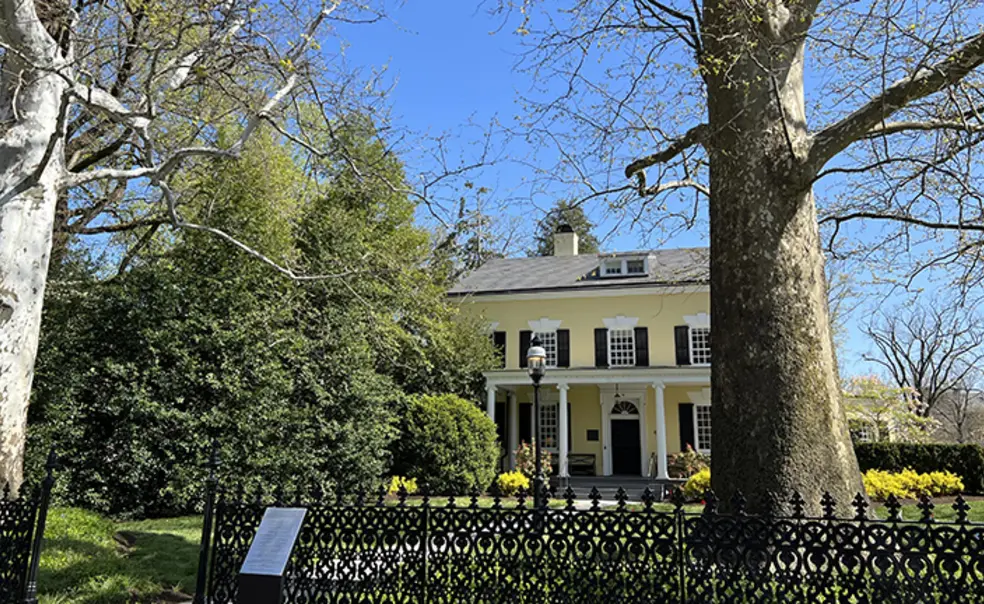Rally ’Round the Cannon: Leafing Home
Poems are made by fools like me,
But only God can make a tree.
— Joyce Kilmer, 1913
At long, long last we return our attention to the physical campus this month, following literally years of what, for alums anyway, has approached banishment from The Best Damn Place of All. The intellectual acceptance of protective steps necessary to sustain the primary mission of the University — whether you define that as scholarship, growth, or worldwide service — during a pandemic doesn’t preclude grieving over enforced separation, which as human phobias go has its own exalted place in the Hang-up Hall of Fame.
The impending cure for this strategic angst is, in the true spirit of human group dynamics, tactical angst. In the bust-out spirit of 1919 and 1946, orange-and-black-minded legions will descend on Mercer County in an attempted replication of last year’s Brood X cicada extravaganza, all in the name of Reunions. Given the sacrosanct nature of the conduct of these gatherings, at least in “normal” times, attempting to align the high demand (two full graduation ceremonies, dozens of deferred major reunions, campus group receptions, personal encounters, brainwashings of children, you know the drill) to the fixed supply, i.e. one standard campus, is an obvious impending implosion worthy of the fusion laboratory. Just for that extra dash of spice, almost everything on campus south of McCosh Walk seems to be ripped up for construction, except of course the P-rade route, which likely received dispensation from the Dean of the Chapel.
So then, on the theory that we will have our overfill of Princeton people later in the month if not before, perhaps we should find an alternative for our musings in the History Corner today, so as not to add to the agoraphobia. The obvious candidate: trees. Certainly a highlight of the campus, and refreshingly nonverbal, they seem at first glance a particularly stylish attempt to rise above the madding crowd, literally. Even those cicadas seem to prefer them to people.
It’s not our goal here to relate the provenance and dramatic highlights of each historic tree, of course — there are fine works available to do that at your leisure, notably a feature story here in Your Favorite Periodical a few years back by the stalwart Barksdale Maynard ’88, a really uplifting impressionist video to get you in the mood for Goin’ Back, and a nicely concise booklet from the University with that most practical of all contemplative support paraphernalia — a map. There you can decipher the sites of my own personal favorites, the cedar of Lebanon outside my junior dorm room and the dawn redwood in Prospect Garden. The latter has a tale that, for an institution with an outlook of millennia, has to be irresistible: It was extinct. Well, obviously not that extinct, but it was known only from fossils prior to being rediscovered a hundred feet tall among rice paddies in the lowlands of interior China during World War II. A worldwide effort to resuscitate and protect the species — the only one of its genus extant — has basically succeeded, with replanted seedlings thriving in globally dispersed locales. But it bears cones only fitfully, and 75 years after rediscovery the dawn redwood is still officially regarded as endangered.
For a real Princeton history adventure, though, all this wonderful greenery takes a back seat to the guardians of Maclean House (originally the president’s house), the Stamp Act sycamores, legendarily planted by the trustees to celebrate the tax’s repeal in 1766. These two huge, gnarly, and, to be honest, somewhat worn-looking specimens overarching Nassau Street have certainly earned their stripes, not only for their 250-year longevity (sycamores can easily live 600 years, however these are in a highly trafficked area) but for what they have come to teach us about the fragility of history itself, even in circumstances where we might expect clarity. It’s always wise to recall that the age of TMI (“too much information”) does not in most cases extend back that far, and that what we feel our forebears should have documented is just not, in many instances, what they felt moved to spend precious time, ink, and foolscap on.
So let’s begin with the basics. The primary data source for the College’s history in the 18th century is the dutiful series of minutes of the meetings of the trustees; with the admirable efforts of the Mudd Library staff to digitize them all, we have a highly accessible treasure trove of information regarding what the trustees did, although only up to a point. They didn’t meet often, generally two or three times per year, and each session’s minutes seems about a similar length — two or three typewritten pages worth — regardless of the meeting frequency or import of issues (e.g., College presidents who kept dying). Some meetings indeed never got up and running, usually due to lack of a quorum among those slogging down the high road between New Brunswick and Trenton, but the length of minutes of following meetings is similar despite the delay.
And so when we come to the meeting of September 1765, what we now see in the rearview mirror seems surprising in a few particulars. Parliament had passed the Stamp Act to raise funds from the American colonies the previous March, involving surcharges of startlingly precise gradation on various paper documents and contracts, the preponderance of which fell on legal, publishing, and educational institutions. Ostensibly raising money to be spent on the protection of the colonists, it also included more than a whiff of both discouraging a homegrown American professional and manufacturing class and furthering the authority of the Anglican church. Essentially every word of the Stamp Act was in blatant contravention to the College’s interest, but in neither the June nor September meetings does a mention arise. This was hardly from lack of familiarity or concern. A continentwide Congress including New Jersey delegates had been called for two weeks later in New York to compile complaints to the Crown, the first such gathering ever; it eventually drew up a statement of rights, forwarding it to Parliament and young King George III in protest of the act, while not mentioning American independence. This dress rehearsal saved substantial time in preparations for the First Continental Congress nine years later, when the focus had dramatically changed. Meanwhile at Princeton, the protest mantle had been claimed by the 31 graduating students (you’re shocked, surely…) who concocted a great PR effort by eschewing their fancy British duds and wearing only homespun clothing of American manufacture to their graduation, also the occasion for the September trustees’ meeting. Their orations were entitled Patriotism, Liberty, Frugality, and Industry. It was a great press sensation across the colony and beyond. Nonetheless, not the slightest allusion to the issue, the act, the congress, the speeches, or even haberdashery arose in the placid minutes.
There is, however, a terse paragraph deputizing one trustee to acquire (this is before the act’s repeal, remember) for planting in the College yard some “button-wood trees” (now more familiarly known as sycamores); no reason is given. If one reads sufficiently in these 19th-century minutes to pick up their style, this seems almost mystical. Usual concerns escalating to the trustees often involved collecting IOUs from recalcitrant students, overseeing lotteries, fine-tuning salaries, and other such fiscal burdens; they involved veiled debates of religious vs. humanistic education and faculty; they involved choosing, hiring, and burying a succession of four presidents in the first 10 years after moving to Princeton. They did not include landscaping; in fact, the only other mention of flora during the time involves keeping townies from filching wood from the forest deeded to the college as part of its package deal to move to the town in 1756.
In the inexorable march of time, the November 1765 meeting was canceled due to absence of a quorum. The despised Stamp Act was then repealed in March, presumably about when the two trees were planted without remark. By the June 1766 meeting, President Samuel Finley (the fourth of the four to die) was mortally ill, but the trustees took time to carefully craft a letter of commendation to the king in honor of his personal intervention enacting the Stamp Act’s repeal. On July 17, Finley died; his slaves were then sold on the front lawn of the president’s house, adjacent to the new button-woods. The trustees, with rival Old Side Presbyterians from Philadelphia literally hovering in the corridor outside their meetings, began the arduous two-year process of hiring John Witherspoon from Scotland to reboot the College. Beyond the eventual receipt of polite thanks from the king, neither the act nor the trees are ever mentioned again, apart or together.
I do believe at this point I’ve read every set of College trustees’ minutes from 1746 through 1794, the end of the Witherspoon administration, many of them multiple times. If there is any mention of landscaping there beyond the mystical button-woods, it has escaped me. So perhaps we might do better attributing our staunch sycamores less to the king and more to divine intervention. Joyce Kilmer, the great New Jerseyan (you can tell: There’s a turnpike plaza named for him) would be on our side.











No responses yet